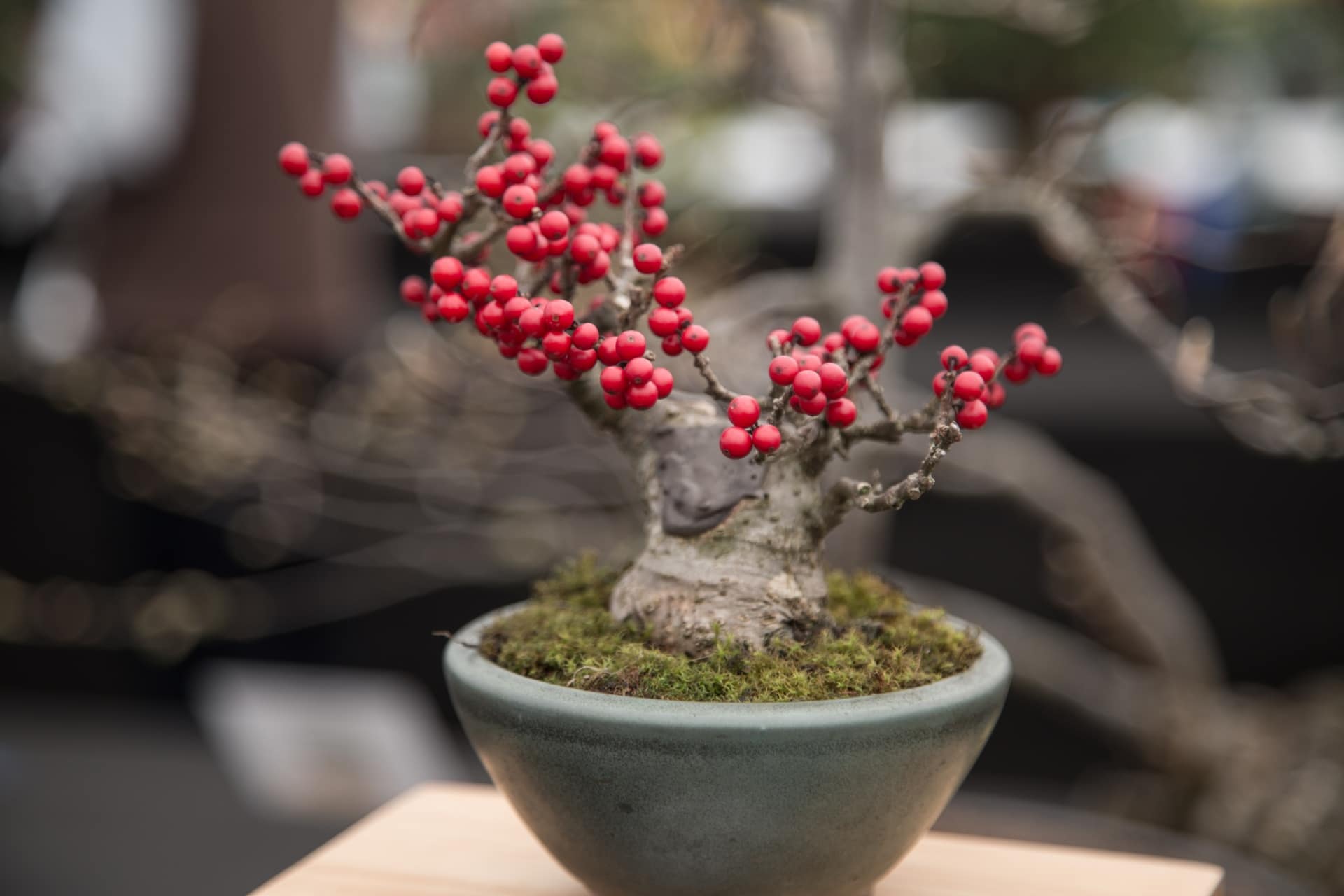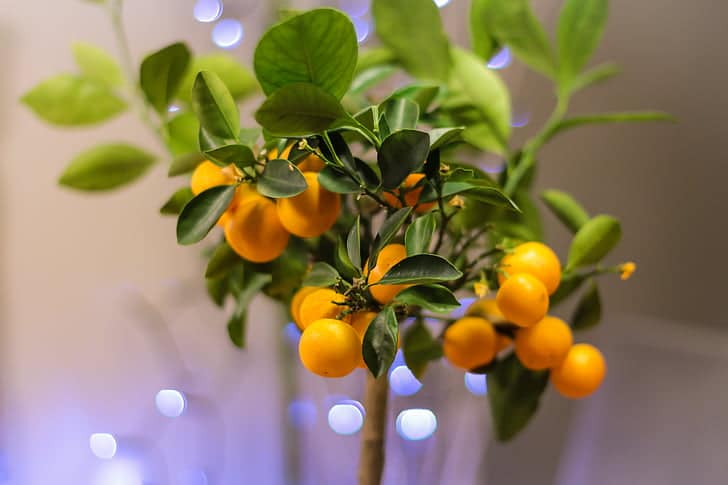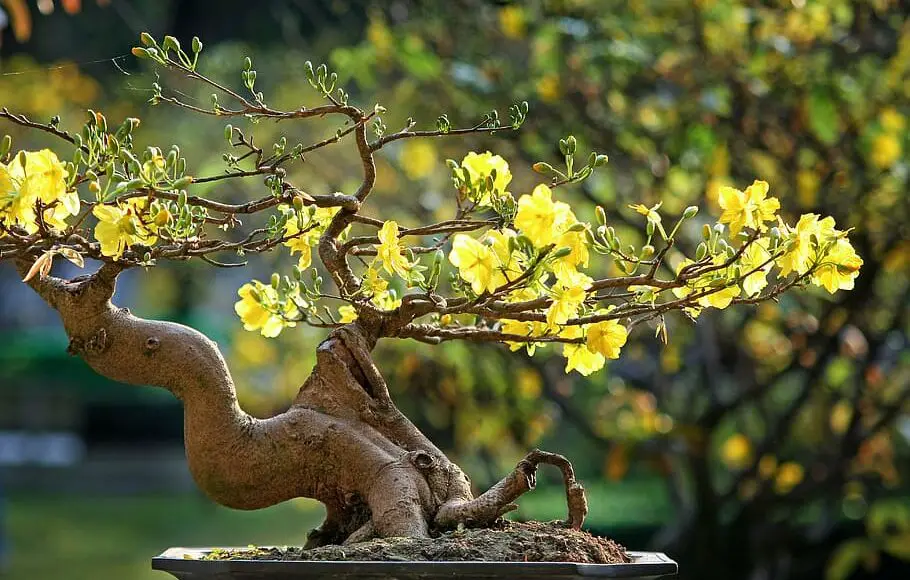Bonsai trees are an amazing art form, and they have been steadily growing in popularity for years. They play to the delight that most humans seem to feel when they see anything miniature, but what happens if you miniaturize a fruiting tree?
Let’s learn about eleven bonsai trees that grow fruit because there are some absolutely amazing examples out there.
Some of the most popular fruiting bonsai trees include the crab apple, certain citrus trees, and the stunning Callicarpa Japonica Bonsai, which has amazing purple fruits. You may also have heard of the Japanese winterberry, the mulberry, and the Fuji cherry. All of these can, astonishingly, produce perfect and edible fruits that are beautiful to behold.
Can Bonsai Trees Really Bear Fruit?
Yes, they can! The idea behind the art of bonsai is that you maintain the tree in perfect miniature form. The growth is not unhealthily stunted and the tree is not naturally small – it is just an amazing way of making plants grow into tiny versions of themselves.
There are a great number of fruit trees that can be turned into bonsai trees, and if cared for correctly, yes, they will bear fruit in all their miniature glory.
There is nothing quite as magical as seeing the branches produce their own fruits, and this really completes the picture that bonsai trees create – a whole world made small.

What is strange about fruiting bonsai trees, however, is that they do not produce the fruit in miniature. Fruits will remain approximately the size that would be produced by the tree if it was fully grown or only a bit smaller.
This obviously presents quite a challenge for growers and limits the number of fruiting trees that are suitable for this treatment.
If you just grow any old fruit tree in bonsai form, you may find that the fruits are far too heavy for the tree, and the branches break when it tries to produce them. The fruits will also look out of scale with the rest of the tree, spoiling the image of a perfect tiny world.
If you aren’t interested in the aesthetic, you may be happy to try this anyway. You can always give the tree more support when it is fruiting to stop the branches from breaking. However, a lot of people do care what their bonsai tree looks like, and want to make the fruit feel in proportion with the rest of the plant. That is why most people choose trees that have naturally small fruits to turn into bonsai trees.
If you’re keen to try this, many kinds of trees are suitable for it, which we will cover shortly. You can have a great deal of fun making bonsai trees fruit, but it is important to choose suitable varieties, or you may be disappointed or damage your carefully tended tree when it tries to fruit.
Can You Eat The Fruits?
Some people believe bonsai trees are genetically modified, and that the fruits might therefore be unsafe. Others might conclude that the fruits will be bitter or unripe. Neither of these things is true, however.
You can certainly eat the fruit from a bonsai tree, provided the fruit is edible in the standard-sized tree. Many people love being able to pick from a harvest grown in their own home, and there’s something magical about this.
If your bonsai tree has produced fruit, you’ll probably find it is indistinguishable from the normal thing. Of course, your tree may not produce a massive crop, since it is a very small plant, but it is certainly possible to get edible fruits from a bonsai tree – so enjoy them!
Pomegranate Fruiting Bonsai
The pomegranate may be best known for its association with Greek myths, but it is also an incredibly pretty tree, and you can create your very own miniature version (or buy one) in bonsai form.

These trees are stunning, and the pomegranates look so cute hanging from the branches. They are not out of scale, and the brilliant red looks great against the dark green leaves.
Fig Bonsai
If you live in a hot country or you have space in a warm room for your bonsai tree (remember, some bonsai trees are quite large, so you need enough space), a fig is a great fruiting tree to try, and it will bear edible fruit for you to enjoy.
Figs would rather be outdoors, growing in the sun, and some depend on wasps for pollination, so you may want to grow your bonsai fig outside if possible. This will increase the chances of you getting edible fruit to enjoy.
If you can’t grow the fig bonsai outside, you can still try indoors, as long as you can provide a warm environment. The trees look wonderful, with the lovely leaves of the fig in perfect miniature.
Crab Apple Bonsai
This is one of the most popular trees to grow in bonsai form, so it’s well worth giving this a go. You will get gorgeous, in-scale apples covering your tree if you are lucky. Crab apples can also produce very beautiful miniature flowers, which look lovely on the tree.
You can get a range of different kinds of crab apple trees, meaning you can decide whether you would rather have yellow fruit or red fruit. The apple tree’s somewhat gnarled bark makes it a wonderful, characterful option for turning into a bonsai tree.
Popular kinds include the Calloway (for red fruit) and the Harvest Gold (for yellow fruit), and you will get the added benefit of stunning golden leaves when fall comes.
Citrus Bonsai
Citrus bonsai trees do sometimes produce scaled-down fruit, and these can look simply stunning on the branches. The striking colors of lemons and oranges are really ideal for bonsai trees because they stand out against the leaves and look great even before you get up close.
You might want to try something like the meyer lemon, which will produce full-sized and bright yellow lemons on its branches. You can cut off and use these lemons just as you would lemons bought from a store. Win-win!
If you would rather have an orange bonsai tree, consider the calamondin orange tree, which has a very long flowering and fruiting season. Its flowers are amazingly fragrant and will make your home smell just stunning while it is in bloom.

The fruits are edible, but they aren’t wonderful, and many people grow these for the aesthetic rather than the taste. They also take about a year to ripen, so you aren’t looking at a quick producer here! The calamondin orange tree is also better when grown outdoors, so you need to live in a warm enough place to make this work.
Limes are also a lovely option if you want a citrus bonsai tree, although the green fruit will not be quite so visible against the green foliage. They still look wonderful, however, so consider this if lemons and oranges aren’t taking your fancy.
Callicarpa Japonica Bonsai
If you want a bonsai tree that looks truly unique and absolutely extraordinary, this is the one for you. Those rich purple fruits are such an unusual color – there isn’t much else like them!
They are also perfectly in scale with the tree, so if aesthetics matter to you, these are a great option all around.
They look rather like large plums or nectarines would on a full-size tree, so they really do work. If you want to create a miniature world, this is probably one of the most beautiful and perfectly scaled options you could find. The tree is also aesthetically pleasing even without its fruits, so this is a good all-around choice.
Olive Bonsai
If you love olives, this tree is perfect for you. The olive tree’s pretty bark and lovely elongated leaves are ideal for miniaturizing, and the fruit is then wonderfully in scale, so you don’t need to worry about damage to the branches or a problem with the aesthetics.
You can eat and enjoy the olives, although you probably won’t get much of a harvest from an olive bonsai tree. All the same, it’s a wonderful thing to be able to pick your own fruit!
Star Fruit Bonsai
For anyone who wants a somewhat alien – but still extremely attractive – display, a star fruit bonsai might be the best option. The fruit makes a beautifully harmonious wash of color against the leaves, with their green and yellow tinting blending nicely.

The shape of the star fruit is very enticing; the smallness of the tree makes it look like a scaled-up version, and you can imagine lifting a fruit down with both hands and holding it rather like a melon. What a weird idea, but very appealing!
The trunk of a star fruit is also attractive for turning into a bonsai. With globular, rounded curves and dips, it is highly appealing and intricate in miniature and manages to mimic the full-size tree very well.
Red Currant Bonsai
If you prefer striking and bold color combinations, the red currant is probably the best bonsai tree option for you. It looks phenomenal when in fruit, with its brilliant red berries standing out against the shaped green leaves.
Again, because the fruits are small in the normal size tree, they look very “right” on the branches of a tiny red currant. The way that the fruits drip down in long, juicy bunches makes this an immensely appealing option.
The leaves are also very attractive, with their intricate, serrated edges and multiple points. With a dark trunk to complement the bright berries, these are unquestionably among the prettiest and most striking fruiting bonsai trees.
Cherry Bonsai
Another option for displaying bright berries against a darker background, a cherry bonsai tree may strike your fancy. You might want to choose an evergreen cherry so that it maintains its lovely leaves throughout the year.
The Bright ‘n Tight cultivar is particularly popular as a bonsai option, and it has sweet-scented flowers in the spring, which will fill your home with a gorgeous smell. These then develop into rich, deep black cherries that you can eat or just enjoy for their extraordinary aesthetic.
Apricot Bonsai
You might prefer a brilliant orange, and an apricot bonsai is perfect for the job if so. Again, with a vibrant color set off against darker leaves, it is a gorgeous option that will produce edible fruits and look very impressive while doing so.
The Japanese apricot bonsai is an early flowerer, so if you want a tree that’s in bloom by the end of January, this is the one for you!
American Persimmon Bonsai
If you aren’t a fan of apricots but you still like the idea of producing bright orange fruits on your bonsai tree, an American persimmon could be the answer.
These look great and taste great, and the fruits are reasonably in scale with the rest of the tree, so they are a good option in terms of creating the “right” aesthetic for your miniature world.
Grow them with some moss around the base to create a carpet of green, or opt for a bright pot to match the brightness of the fruit. Again, you won’t get a huge amount of fruit from a persimmon bonsai tree, but these look wonderful.
The fruits tend to be nicely spaced out, too, which is good if you don’t like the big clusters you might get on other fruiting trees. Pluck them carefully when they are ready, so you don’t snap the delicate branches.
Conclusion
Many different bonsai trees can grow fruit, and if you are interested in growing a fruiting bonsai, you’re in luck! Just pick your favorite kind of tree and see if it is suitable for becoming a bonsai; the chances are that it will be.
You can amaze your friends (and probably yourself) by growing a tiny tree with the option to eat the fruit and create a work of art to display in your home or your yard.
